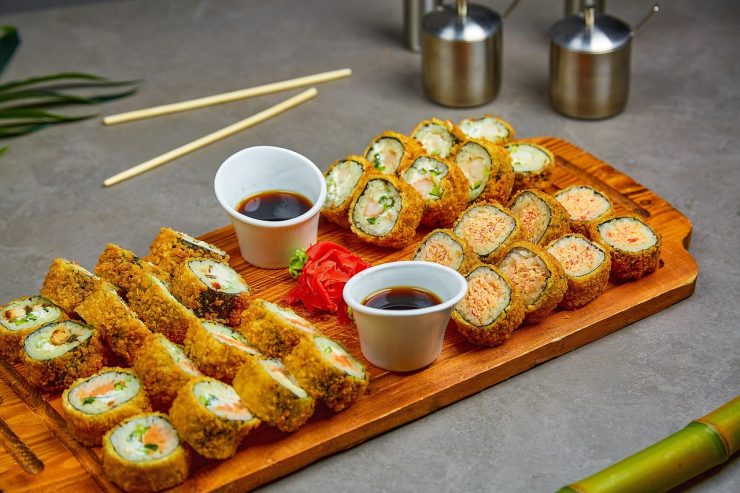Is Sushi Really a Healthy Meal?
Sushi often gets a glowing reputation as a healthy, low-fat option—fish, vegetables, seaweed, and rice all wrapped up into a neat little roll. But whether sushi is truly a healthy choice really depends on what’s inside and where it’s being ordered from. While it can absolutely be a nutritious meal, it can also come with a surprising amount of processed ingredients, refined carbs, and unhealthy additives.
The Fish Factor
The quality and type of fish used in sushi is key. However, not all sushi fish is what it claims to be. In fact, DNA testing by seafood watchdog Oceana found widespread mislabeling—up to 87% of red snapper and 60% of tuna samples were mislabeled. Even high-end restaurants in major cities weren’t immune, with some showing up to 74% mislabeling.
Beyond labeling concerns, there are also issues with toxins in certain types of fish. Tuna, for example, is known to contain higher levels of mercury and other contaminants like PCBs and dioxins. Fatty tuna used in sushi, such as bluefin akami and bigeye, tends to accumulate even more toxins due to fat content. Yellowfin and bluefin toro may be better options if available and accurately labeled.
Shrimp, especially if farmed, is another seafood to approach with caution. Around 94% of shrimp consumed is farm-raised, often under questionable conditions in overseas facilities. Farmed shrimp may contain harmful chemicals and is considered one of the less healthy seafood choices. Wild shrimp is a safer bet when available.
Crab also has its caveats. It’s common for sushi restaurants to use imitation crab, which isn’t always labeled clearly. Imitation crab is a processed mix that often includes a long list of additives—such as starches, flavorings, colorants, and preservatives. While not necessarily dangerous in small amounts, it’s far from a whole, natural food.
What’s Really in the Seaweed Salad?
Seaweed can be a powerhouse of nutrients, offering iodine, minerals, and antioxidants. However, nori—the seaweed wrap used in sushi—can sometimes contain environmental toxins and heavy metals, depending on the source. It’s best to look for organic or verified-clean seaweed whenever possible.
As for seaweed salad, that bright green color can be a red flag. Many are prepackaged and loaded with ingredients like high fructose corn syrup, artificial colors, MSG, and processed oils. Asking whether the salad is house-made can help avoid these hidden extras.
The Truth About Wasabi and Ginger
Wasabi served with sushi is rarely the real thing. Most wasabi is a blend of horseradish, mustard, cornstarch, and food coloring. While real wasabi has health benefits, the substitute isn’t necessarily harmful—it’s just not authentic.
Pickled ginger is another sushi staple with potential additives. Many versions are processed with sweeteners, preservatives, and artificial dyes like Red #40. The fresher and more natural the ginger, the better—so it’s worth asking if it’s made in-house.
Other Hidden Ingredients: Soy Sauce, Rice, and Roe
Soy sauce often contains MSG, preservatives, and genetically modified soy. Sushi rice, too, can be a surprise—it’s commonly seasoned with sugar and sometimes artificial sweeteners like aspartame. Fish roe, or fish eggs, may be dyed and preserved with synthetic ingredients as well.
Sushi: Not as Low Calorie as It Seems
One sushi roll can clock in at 250–350 calories, largely due to the white rice—sometimes making up 75% of the roll. That’s the carb equivalent of four slices of white bread. With two or three rolls in a typical sushi meal, plus soup or salad, calories can easily climb past 1,000. Add-ons like tempura, mayo-based sauces, and cream cheese increase the fat and calorie content even more.
Smarter Sushi Choices
Eating sushi can still be part of a healthy diet—it just takes a little awareness. Choosing high-quality restaurants, especially those that make ingredients from scratch, can reduce exposure to processed items. Wild-caught fish is preferable, and yellowfin tuna or wild salmon are generally better options than farmed fish or bigeye tuna.
Ordering sashimi—sliced raw fish without the rice—can help cut out excess carbs. Some places also offer rolls wrapped in cucumber instead of rice, often referred to as “Suki Maki.” Asking about ingredients like real crab, freshly made ginger, and low-sodium soy sauce can make a difference too.
Bottom Line
Sushi isn’t inherently unhealthy, but it’s not always the wholesome meal it appears to be. Between refined carbs, added sugars, processed sauces, and questionable seafood sources, there’s room for improvement. Choosing wisely, asking questions, and skipping the most processed options can help turn sushi into a smarter, cleaner dining choice.











